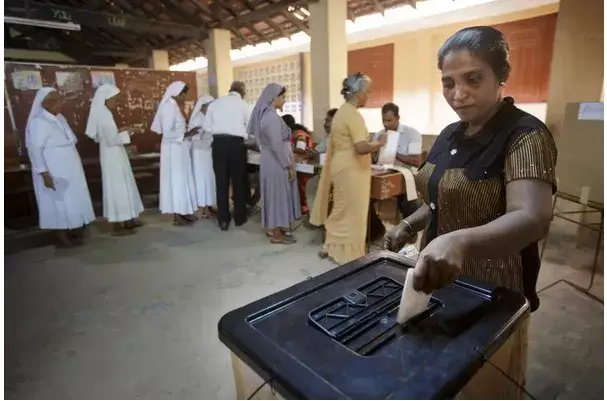Tectronic Shift In Sri Lanka Tamil Politics
National Peoples’ Power party sweeps the polls;

In the November 5 Sri Lankan parliamentary elections, the National Peoples’ Power (NPP) swept the Sinhala-dominated areas of the island, as predicted by many. The Sinhalas are the majority community in Sri Lanka and the NPP had the reputation of being a Sinhala nationalist party.
What came as a surprise was the NPP’s sterling performance in the Tamil and Muslim-dominated areas of North and East Sri Lanka.
Breaking with a seven-decade tradition, Sri Lankan Tamils flocked to the all-island National Peoples’ Power (NPP) party in preference to ethnic Tamil parties. Concern for good governance appears to have outweighed interest in traditional political issues like autonomy and accountability for alleged war crimes.
The NPP put the Tamils’ favourite party, the Ilankai Tamil Arasu Katchi (ITAK), in the shade, and emerged as the number one choice in most of the electorates in the Tamil and minorities dominated Northern and Eastern provinces.
The NPP’s performance was impressive especially taking into account the fact that the party was a total “outsider” to the area. It was a “Sinhalese” party which had no presence at all in the Tamil-dominated North ever before.
The NPP was also contesting in an area which had an enormous number of candidates vying for votes. In the Jaffna constituency for instance, there were 44 parties and Independent groups in the fray.
In Vaddukoddai, in Jaffna district, which had been an ITAK stronghold, the NPP came first, getting 21.5% of the votes; the All Ceylon Tamil Congress (ACTC) came second with 13.48%; and the ITAK came third with 13.39%. The rest went to the Democratic Tamil National Alliance (DTNA) and Independent groups.
In Kankesanthurai also, the NPP was in the lead with 13.37% of the votes. The ITAK got 12.57%; and the ACTC 7.15%. In Manipay, the share of votes had NPP at the top with 30.94%; and ITAK at number two with 13.49%. In Koppai, the NPP secured 29.86% and the ITAK 12.63%. The score in Uddipiddy was NPP 20.16% and ITAK 15.07%.
In Point Pedro too, the NPP came first with 21.89 % and the ITAK second with 19.71%. In Nallur, a Hindu stronghold, the NPP came first with 31.44% and ITAK third with 11.49%. In Jaffna proper, NPP came first with 41.46% and ITAK second with 11.81%.
However, in Kayts and Chavakacheri, the NPP got less votes than the Eelam Peoples Democratic Party (EPDP) and an Independent Group. In Kilinochchi, the ITAK President S.Sritharan’s pocket borough, the ITAK bagged 43.79% of the votes and came first. The NPP came second with 16.39%.
In Kalkuda in Batticaloa district in the Eastern province, the ITAK was the top scorer with 28.10 %. But in Batticaloa town, the NPP was first with 27.11% with the ITAK and the Sri Lanka Muslim Congress were slightly behind. In Paddiruppu, the stronghold of the Tamil Makkal Viduthalai Puigam (TMVP), the NPP stood third.
In Trincomalee District, which is ethnically mixed, the NPP got the largest percentage of votes in both Seruvila and Trincomalee town, cornering 56% and 40% respectively. In Mutur, the NPP came second to the Samagi Jana Balawegaya (SJB).
In Digamadulla (Amparai) district, the NPP was the top scorer in Amparai town, Sammanthurai and Kalmunai. It was second to the Sri Lanka Muslim Congress (SLMC) in Pottuvil.
The election results show that the rhetoric of divisive Sinhala nationalism and Tamil nationalism did not dominate the discourse.
Sure, the usual Tamil nationalistic demands for federalism, accountability for alleged war-time atrocities, vacation of occupied military lands and the full implementation of the 13 th.amendment for more power devolution, were voiced by the Tamil contestants. But a substantial section of voters overlooked those issues and pitched for better governance, less corruption and more people-centred development promised by the NPP.
Tamils voted for the NPP despite the fact the NPP’s election manifesto had nothing to say on the Tamils’ issues as such. It promised a new constitution, but left its contents vague, leaving the matter to the parliament to be elected.
This was neither here nor there. And yet, the Tamils voted for the NPP because their attention was elsewhere, on their deteriorating economic circumstances created by the COVID 19 pandemic and the economic crisis of 2022. They were desperately in need of a government which would give them some relief.
It is not clear as to how the NPP government will bring relief to the people given the lack of financial resources, the dependence on foreign aid and debt repayment obligations.
Ahilan Kadirgamar, a professor at the University of Jaffna told Frontline magazine that the lands released from military occupation in the Northern Province could be developed by local cooperatives with a local village level official drawing up plans for their development and use. Development then will be “bottom up” and “top down” as is the case now. It will therefore be more effective. Fisheries could also be decentralised, Kadirgamar added.
Most importantly, the NPP, being a hard core Sinhalese or Sri Lankan nationalist party with no blemishes, can take bold steps to bring about ethnic reconciliation because it cannot be accused of being anti-Sinhala or anti-Sri Lankan.
The Tamils should make use of the window of opportunities which is open now to realize their reasonable demands within the frame of Sri Lanka’s constitution.

